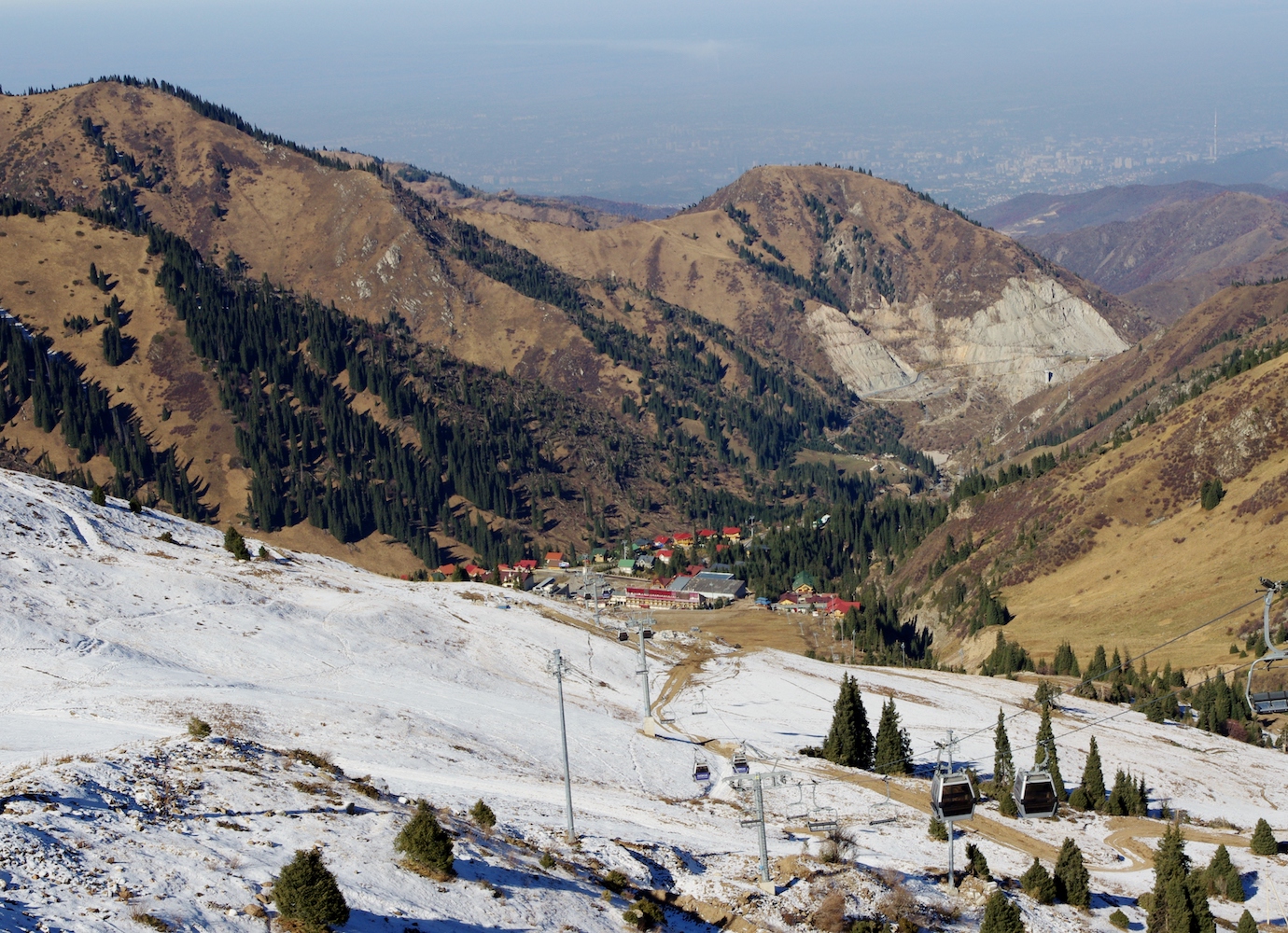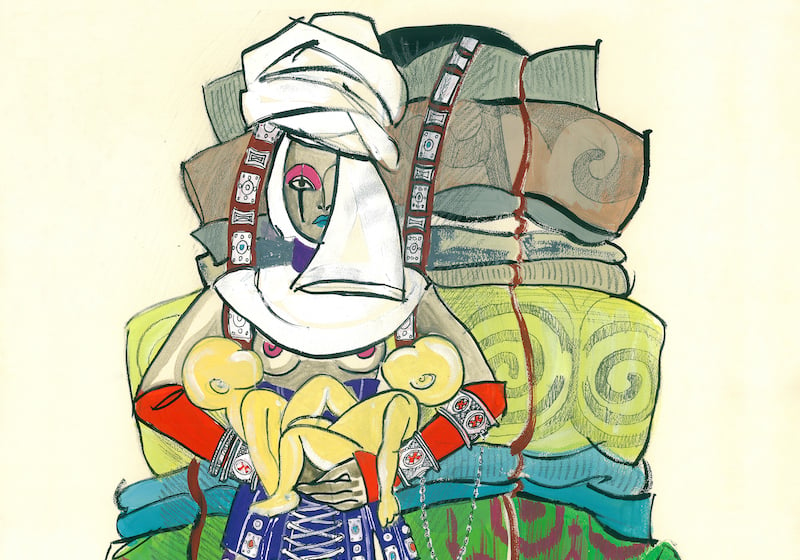Contemporary Kazakhstani culture, it seems, revolves around problems of past and present. With almost 70 years of unarticulated Soviet-era national trauma to grapple with — from the destruction of traditional nomadic lifestyles and the great famine that followed, to the forced assimilation of Kazakh culture and eradication of local intelligentsia — for many, looking to the future still seems unthinkable.
Artists instead have heaped their efforts on healing the nation’s collective consciousness. As a result, the culture that has blossomed from Kazakhstan’s years of independence since 1991 resembles a 30-year therapy session, with directors, artists, and writers all searching to pin down a new, post-colonial Kazakhstan in the modern world.
Independence is not without growing pains. Kazakhstani artists face both financial constraints and limited audiences. But most are simply driven by the joy to seek and manifest their true identity, tracking the social, economic, and political transformations of an emerging nation.
This list brings together some of the country’s most influential works. Diverse in form, style, and technique, many explore Kazakhstan’s most pressing issues, moulding a new national identity.
Film
The Story of a Young Accordionist , 1994
dir. Satybaldy Narymbetov
Satybaldy Narymbetov’s quiet yet poignant story of a boy whose father is sent to a Stalinist prison tackles the deep traumas of the Soviet past. Seven-year-old Yesken fights, plays, and falls in love in what seems a very ordinary childhood, Kazakh village filled with kind, joyful, and diverse people. But what Narymbetov seeks to bring to life against this backdrop of mundanity is a very sinister sense of danger — the sense of never truly being safe, even while within your own home, family, and community. The injustice suffered by Yesken’s father runs like an invisible thread throughout the entire film. Although it remains unseen, it is an inescapable force shaping Yesken’s young life irreparably.
Killer, 1998
dir. Darezhan Omirbayev
Darezhan Omirbayev’s masterpiece won Un Certain Regard at Cannes Film Festival and defined the 1990s and the disoriented people of a newly-independent Kazakhstan. Following a chauffeur who falls in debt to a gangster after a minor traffic accident, the film captures the city of Almaty with a Bresson-like minimalism. The often-impenetrable acting style reflects the stupor of society amid post-independence confusion. Violent and bloody scenes happen off camera, leaving a lingering blend of profoundly melancholic cityscapes. Long static shots are punctured with vivid details that reveal a deeply unbalanced world. In one, a scientist is seen lost in the labyrinthine corridors of a modern office block simply unable to find a way out.
The Owners, 1998
dir. Adilkhan Yerzhanov
After struggling to survive in the city after the death of their mother, three orphaned siblings return to their ancestral home in the countryside with all their belongings. But in the auyl (village) – “the cradle of Kazakh civilisation” – the three are soon disappointed to find more problems, corruption, and inhumanity. Adilkhan Yerzhanov’s film alludes to the young nation state of Kazakhstan, which has long tried to come back to its “ethnic roots” in a bid to rediscover its new identity, following the collapse of the Soviet Union. But as the movie illustrates with Yerzhanov’s usual blend of the absurd and grotesque — all brought to life with a Van Goghean colour palette — “the owners” of Kazakhstan and its countryside are not always living an idyllic life — but can also be unscrupulous, uncultured brutes, just like their former imperialist rulers.
Books
Mythology of the Ancient Kazakhs (in 4 vol., 2004)
by Serikbol Kondybai
A surprisingly comprehensive title, Serikbol Kondybai’s book encapsulates the many national myths that have survived across the centuries in Kazakhstan’s collective memory. Kondybai believes that language can encompass the essence of a people and a nation better than any other medium — and his work proves his point with full force. Chapter by chapter, he reinterprets each narrative with painstaking scrutiny, making unexpected connections with slices of Kazakh culture. He also delves into individual words and names, tracking unique etymologies.
In recent years, Kazakhstan has adopted a new programme called “Mangilik El”, or “The Country of Eternity”, in a bid to promote national values. The movement has seen historians working with archive materials in a bid to revive Kazakhstan’s national history and reinforce national identity. But as Kondybai’s work proves, “the country of eternity” cannot be found in physical objects: it is in each Kazakh’s heart and unconscious mind, sealed, dusty, and disregarded.
Cherish Me (2000)
by Didar Amantay
Didar Amantay’s first book, Post Scriptum (1996), made a splash in Kazakhstan’s literary circles with its unconventional style and themes. The stories made a detour from the social-realist and historical fiction that previously dominated Kazakhstani fiction. It also concerned itself with urban life at a time when most Kazakhstani writers focused on the heavily-romanticised countryside. But Amantay also transformed modern Kazakh literature by focusing on the condition of individual characters, rather than trying to capture the problems on a national scale, whether by attempting to perpetuate stereotypical national values or criticise the status-quo. Cherish Me is a collection of personal stories which delve into the everyday experience of living in modern Kazakhstan. Wrapped up in their own youth, Amantay’s characters savour the sounds, smells, and tastes of city life, becoming a relatable touchstone for a cultural generation coming of age.
Melodies of Gokturks (2002)
by Temirkhan Medetbek
When Temirkhan Medetbek began searching for a new language for an independent Kazakhstan, he landed on the medieval verses of the Göktürks. An ancient nomadic people, Göktürks established the First Turkic Khaganate, which stretched across Central Asia from Mongolia to the Black Sea between 552 and 603 CE. They left traces of their songs and poetry carved into rocks across the area, including in Kazakhstan. The original verses are in ancient Turkic and use a runa: an alphabet not understood by modern Turkic peoples. There are multiple translations of these poems into modern Kazakh, but none have been as artistically powerful as Medetbek’s. In rendering the ancient words of the Göktürks into contemporary Kazakh, Medetbek is able to both critique the repressive past and present, while exploring an expressive new language which conveys the agony of a people reconstructing its own sense of belonging.
Art
Scarab , 1998-9
Moldakul Narymbetov
Moldakul Narymbetov was a leading figure in Kyzyl Traktor, Kazakhstan’s first significant contemporary art movement to experiment with different mediums and forms. The group styled themselves as a transavantgarde artistic tribe, creating an anarchic commune outside of Almaty. Narymbetov himself was known for working across paintings, sculptures, and installation, but he also immersed himself in the artistic performances that came to define Kyzyl Traktor: mixing Kazakh nomadic and shamanistic rituals with elements of Zoroastrianism to try and create a new artistic language. But it is Narymbetov’s series of sculptures known as Scarab that offers blistering comment on Kazakhstan’s modern cultural reality. For many, the artist’s multiple renditions of an intrepid beetle rolling dung show a nation still trapped after years of independence. For others, it hammers home the message that modern culture is only a reproduction of the old, already existing traditions. Ultimately, the meanings behind these installations can be reproduced and re-examined over and over again, just like the recycled rubber used for the sculptures themselves.
My Silk Road to You X, 2016
Almagul Menlibayeva
As one of Kazakhstan’s leading contemporary artists, Almagul Menlibayeva is distinguished by her striking treatment of a wide range of contemporary issues — from gender and the environment to capitalism. Having previously worked with canvas, photography, and video, Menlibayeva’s most current work experiments with digital tools. Her My Silk Road to You series portrays women amid mythical iconic Central Asian redefining regional tropes.
In My Silk Road to You X, traditional Central Asian hats act as reminders of the stereotypes, traditional roles, and responsibilities imposed on women, while a flowing banner of Uzbek fabric prevents the women from speaking. The image’s alternative name — Just Pull My Memory — also explains the explosion that dominates the image. As recollections of the past unravel — the abuses that Central Asian women have faced not only because of their gender but because of their place as a Soviet colony — Menlibayeva’s protagonists are, quite literally, overwhelmed.
Big Information, 2004
Syrlybek Bekbotayev
The series Big Information explores the global power of the media — in this case, the BBC — against the obscurity of the unnamed Kazakh countryside. Written on brick houses and walls, the inverted “C” that is meant to form part of the BBC’s logo instead becomes a crescent, the symbol of Islam.
The series illustrates an ongoing problem in Kazakhstan: how the information that reaches the country’s most vulnerable is often distorted and manipulated by poverty, illiteracy, and ignorance. The problems foregrounded by Big Information are all the more topical during the pandemic: conspiracy theories and anti-vax campaigns have all emerged from the country’s inadequate information policy.
The Red Book, 2019
Almas Nurgozha
In fact, Nurgozha describes using oil paint as embarking on a near-magical dialogue between himself and the canvas, producing unpredictable results. His style is characterised by dynamism, his subjects almost exploding outside of the canvas. One of Nurgozha’s most striking pieces, The Red Book, is named after the crimson-covered catalogue of officially endangered species that exists in many former Soviet countries. It tackles one of the most pressing issues facing the new Kazakhstan: environmental damage both in the country itself and in the world at large. Nurgozha made the painting after a ranger working for Kazakhstan’s Ecology Ministry was killed by poachers hunting saiga antelopes in 2019. Its bloody red canvas invokes the urgency of the issue at hand, while black strokes hint at imminent global destruction. At the heart of the image, the saiga’s desperate expression is a direct response to imminent global environmental disasters.


